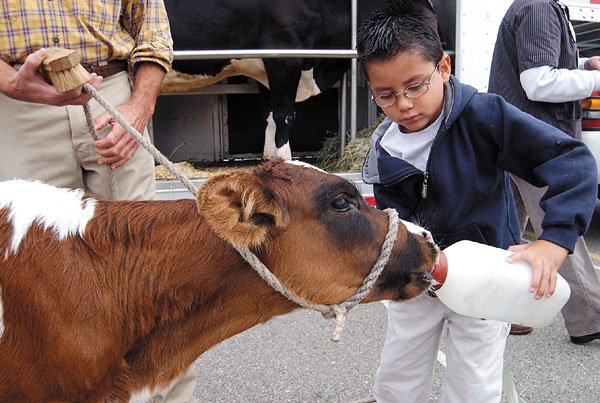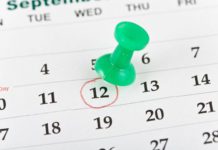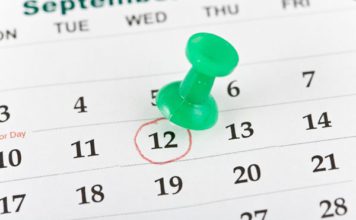Students in kindergarten through third grade at Luigi Aprea
learned valuable lessons about mammals, dairy straight from the
source
– cows
Gilroy – It’s not every day students at Luigi Aprea Elementary School get squirted with milk straight from a cow’s udder, but that’s exactly what happened Monday when the Dairy Council of California’s mobile classroom pulled onto campus.
An 1,800-pound, 8-year-old black and white dairy cow named Electron – Ellie for short – and her caregiver Jeff Byers gave students an up-close and personal lesson on cows, milk, mammals, recycling and gardening. An 11-week old white and reddish-brown calf named Rosemary also made an appearance, graciously allowing the kindergarten through third grade students to stroke her head, neck and back.
Before opening the trailer doors and giving students their first look at the bovine ambassadors, students fidgeted with excitement as Byers explained that cows are where milk come from, and milk ends up in yogurt, ice cream, cheese, butter and the cartons of milk the kids see at school every day. As Byers unlatches the door for Ellie’s grand entrance, many students start craning their necks and bouncing on ground with anticipation.
“We’re going to see a cow!” first grade student Lyndsey Long happily whispers to her neighbor. “Look, he’s opening the cow!”
As students see Ellie standing in the trailer munching on alfalfa hay, they oooh and aaah, many commenting on how big she is. Ellie, in turn, eyes the children with an air of bored interest.
“Ellie is a cow, so please don’t laugh at her when she does cow things,” Byers says to the children. “She might take her long, rough tongue and stick it in her nose – that’s always fun. Or she might urinate or get rid of solid waste. That’s what cows do. I’m her caregiver, so I’ll clean up after her. That’s how it works. I take care of Ellie, I give her food and water, and in return she gives me milk – about 10 gallons a day.”
The students learn that Ellie has four stomachs and no teeth on the top, front portion of her mouth. When she eats, the food goes to her second stomach where it forms into baseball-sized lumps. Then she gives a big “gulp” and the food comes back up into her mouth as cud, and she starts chewing again. Second and third grade students counted along as Ellie chewed 49 times before swallowing. Then they watch Ellie’s neck muscles shift, bringing the food back up, and she begins chewing again.
Byers shows the children a milking machine, explaining that Ellie is milked twice a day – once at 2am and once at 2pm. He talks about how the machine works and how milk comes out warm, but is refrigerated right away to make it last longer. Then he shows the students how they would move their hand if they were going to milk a cow themselves without the help of a machine. Once they understood the motion, Byers moved to Ellie’s udder and demonstrates, spraying the kids in the front row with warm, fresh milk. The students squealed with delight and laughed.
After jokingly “going for the world record of milk squirting”, Byers brought out little Rosemary, the 11-week old calf. The students saw what Rosemary’s bottle looks like and, as she sucked water out of it, Byers put the microphone up to her mouth.
“Squelch, slurp, squish, squelch, slurp, squish,” boomed out of the microphones and students laughed at the sound of Rosemary nursing.
“Cows are very gentle animals, and calves – baby cows – will follow around whoever has their bottle,” Byers said to the students. “If we pulled Ellie out of the trailer, she’d stand here right next to me. Or, we could take her for a walk and go to your house. Then, if you gave her plenty of grass to eat and water to drink, she’d make milk for you, too.”
After Rosemary’s bottle was left mostly empty, Byers talked about what cows eat, showing students slightly discolored artichokes that grocery stores can’t sell. He explained that these artichokes, along with celery stalk pieces, broccoli stalks and other fresh produce that can’t be sold in stores often make up at least part of a cow’s diet. He explained how, in turn, a cow’s manure is often processed and used as fertilizer in the soil used to grow this produce. He also pointed out the anatomy of a cow, showing students where a cow’s shoulders, hips and spine are located.
“I think the cows are pretty cool,” said third grade student Justin Nelson. “I liked it when he squirted the milk.”
Byers said it was important to him to be part of the Dairy Council’s mobile dairy classroom program because he felt many students had more opportunities to see wild animals at zoos than they have to see farm animals.
“Also, it’s like Mark Twain was saying about kids’ memories being well-stocked, but not their understanding,” said Byers, who brought Ellie to Gilroy from Moon Glow Dairy in Moss Landing. “It’s good to let the kids see cows up close, see how gentle and calm they are despite being so large, and they get to see what wonderful creatures cows are. The program has been received really well.”
For the grand finale, students walked by Rosemary in a single-file line and got to pet her. Some students smelled their hands after petting Rosemary, but most just compared notes about where they got to pet the calf.
“The Dairy Council doesn’t do this very often, but I’ve seen the presentation done at other schools I’ve been at,” said Maria Wetzel, principal at Luigi Aprea. “So, when I got the flyer that they were offering the program again, I started making the calls and sending in the forms. That was back in March or April. But, we finally got them here, and I think it’s an important thing for the students to see. Not many of them know exactly where milk or cheese comes from, so they got to see that and what a cow looks like up close. It’s a really good experience and the presentation is really wonderful. I’m so happy we got them to come.”














